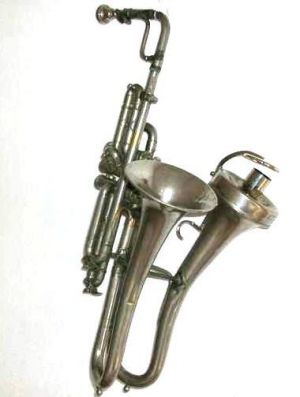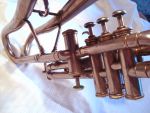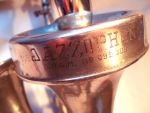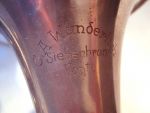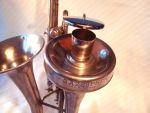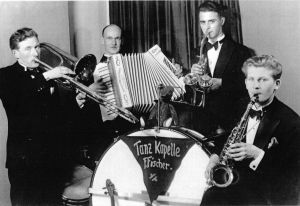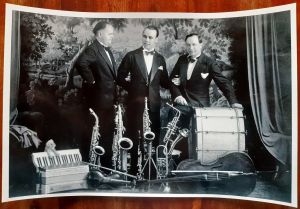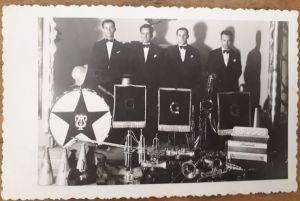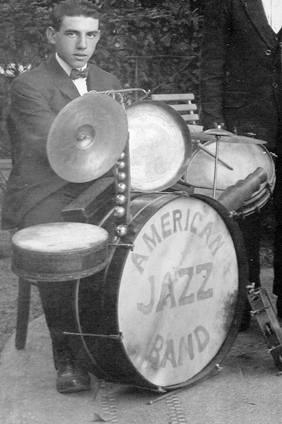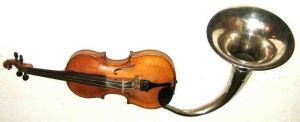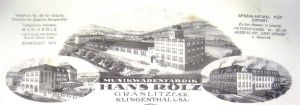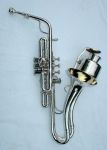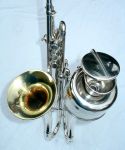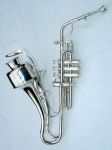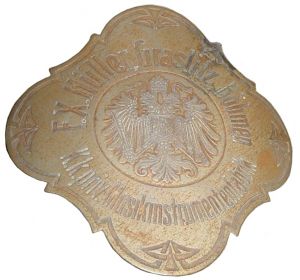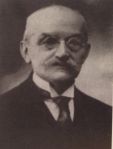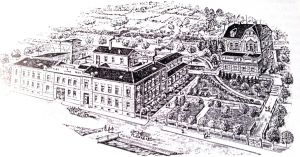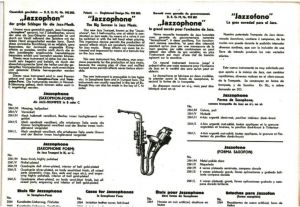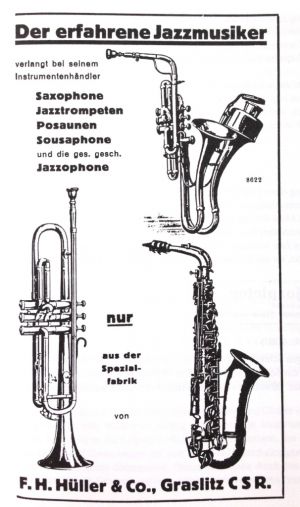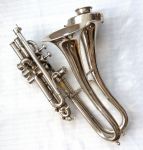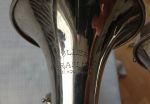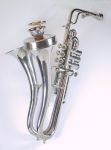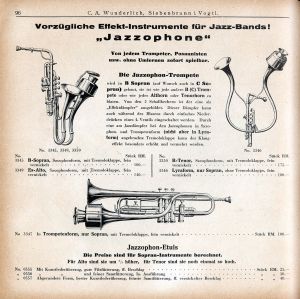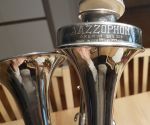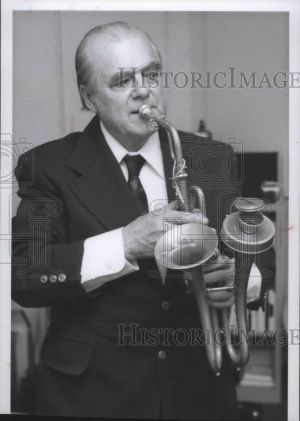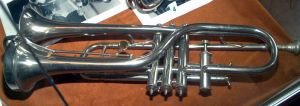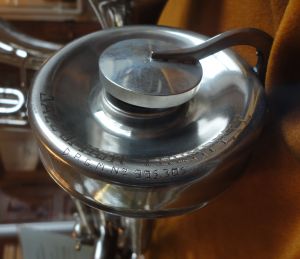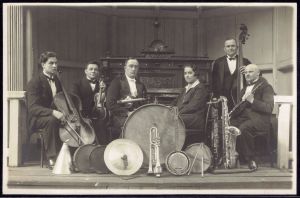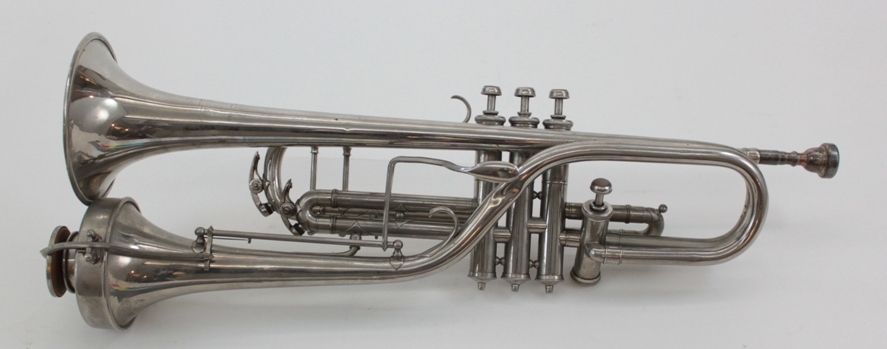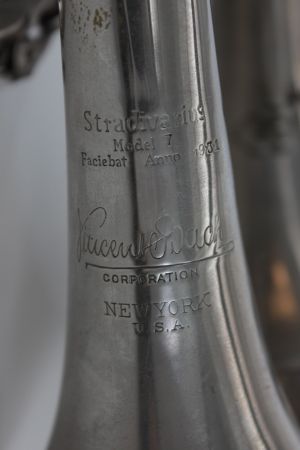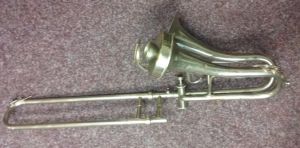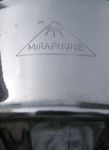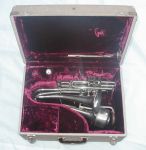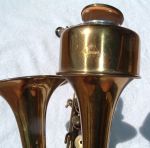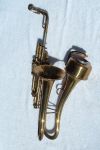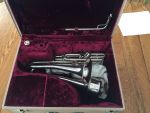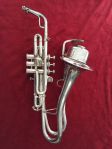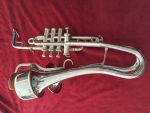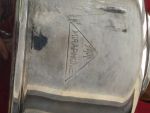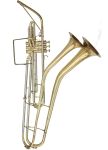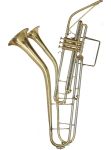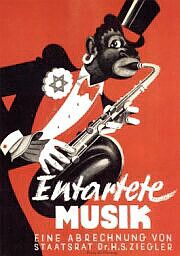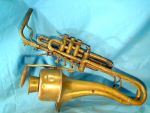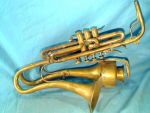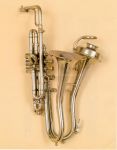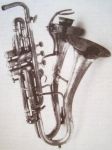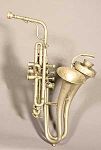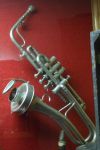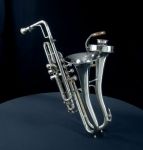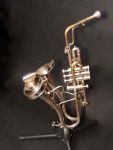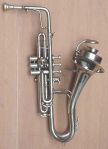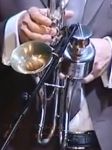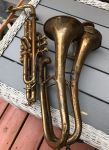Jazzophone
The Jazzophon is an almost forgotten instrument, a trumpet in the shape of a saxophone with two bells. One bell sounds like a normal trumpet, the other like a muted trumpet. In a July 3rd, 2011 recording Scott Robinson shows the possibilities of the instrument. The Jazzophon was invented in the nineteen twenties as a cheap alternative to the then very popular saxophone. The Jazzophon is played with a trumpet-mouthpiece and has the three regular trumpet valves plus one valve upside down. When pushed down that extra valve switches between the two bells, one of which has a built-in wah-wah mute. The Jazzophon was not a success, like the Normaphone and many other newly invented saxophone-like instruments from that period. Did it disappear because Hitler's Germany wasn't very fond of jazz or because the crisis hit? Or was it a lack of suitable music or was it too difficult to play? It is not clear.
I stumbled across the Jazzophon early in 2010, when Gertjan Hos from Assendelft offered one for sale. It was taken home to Holland shortly after World War II by a friend's uncle who had worked in the German Arbeitseinsatz. Hos stated there was only one other one around in the world, in America. That tickled my curiosity and I started researching. So, here you'll find everything you always wanted to know about the Jazzophon, and much more.
Marked Jazzophon D.G.R.M. 995.305 on the mute and C.A. Wunderlich Siebenbrunn Vogtl. on the open bell. Stem and trigger replaced in 2002 by Helmuth Voigt in Markneukirchen. Coll. Gerard Westerhof
Contents
- 1 The Musikwinkel in Vogtland
- 2 Background of the Jazzophon
- 3 The end of the Jazzophone
- 4 Jazzophons overview
The Musikwinkel in Vogtland
The roots of the Jazzophon lie in the area of Graslitz in Bohemia and Markneukirchen in the Saxonian Vogtland, an area that acted for years as the world's musicstore. This region was called the Musikwinkel. Bohemia an Saxonia were, apart from a short interval around World War II, part of different countries/empires. There were however close connections. Refugees from the Graslitz-region started producing musical instruments in the 17th century in Markneukirchen after they were forced to leave the recatholicising Bohemia. They started with violins, then gitars and cithers, woodwinds, harmonicas until almost every orchestral instrument was made in this region. At the start of the 20th century the instruments from the Musikwinkel-region had a 50 percent share of the worldwide market, with Graslitz being a leading wind instrument producer. Instruments and parts came from factories (mainly Graslitz), workshops or were home made and traded all over the world. From 1893 untill 1916 there even was a U.S. Consulate General represented in Markneukirchen. At that time Markneukirchen was about the wealthiest city of Germany, the wholesalers being the millionaires rather than the instrument makers.
Background of the Jazzophon
The saxophone was invented by wikipedia: Adolphe Sax in 1841. He wanted to create an instrument that would both be the loudest of the woodwinds and the most versatile of the brass, and would fill the then vacant middle ground between the two sections. In the Roaring Twenties the saxophone became extremely popular as being the ultimate jazz-instrument. By the mid-twenties there was undoubtedly a saxophone boom, fuelled by a post-war demand for novelty. Production of saxophones in America reached a peak in 1924, when 100,000 instruments were produced. Five hundred thousand saxophones were sold in seven years, until the Wall Street crash signalled an end to this boost to the saxophone's popularity. In the 1920s, wikipedia:Jazz in Germany was a fad. Eager to look ahead after the crushing defeat of World War I, the part of Weimar Germany that embraced the modernism that swept through Europe was crazy about jazz. The "Salonorchester" turned to the new style, because dancers wanted it so. Radio also played a role in the popularization of jazz. In 1926, it began to regularly play jazz music, and by 1930 artists such as Louis Armstrong, Duke Ellington and others became popular to German audiences. People saw jazz as the "essence of the era's modernism," a strong surge toward greater equality and emancipation, posing as a perfect advocate for a democracy in Germany. Trumpets were played in German jazz bands as of 1924, mostly by players that also played violin or so. The trumpet was, like the trombone and the saxophone regarded as kind of a witty instrument, especially with the use of mutes. In the light music there was a shift from Tanz-Kapelle and Salonorchester to jazz-bands in different line-ups.
One of the few pictures showing an orchestra with a Jazzophon is this one, found in the Trompetenmuseum in Bad Säckingen, with Tanz Kapelle F. Fischer.
Another one, on a postcard, the Ebay seller suggests that it might be from Dresden.
And yet another postcard (detected by Vaclav Muska), dated 7.8.1938 on the backside. It shows an orchestra with four musicians who play trumpets, violins, an accordion, saxophones and a bass drum. And a Jazzophon.
A similar spirit was found in Czechoslovakia, one of the successor states after the collapse of the Habsburg Monarchy. It was a state that was markedly heterogeneous ethnically and economically. Most of the industrially and culturally advanced towns lay in the western part of the country with predominantly Czech and German populations (which meant that here the conditions for the development of modern dance culture were much better). Energetic dance music from overseas found what were in many respects favorable initial conditions here. The new state became in the inter-war period one of the most economically successful of European countries. While Czechoslovakia did not have very strong cultural contacts with the United States, it was orientated culturally to England and France, i.e. the countries that were the first in Europe to get to know jazz. Naturally, then, Czech Bohemians, intellectuals, but also businessmen, wanted to enjoy their "roaring twenties" with the same intensity that they saw in the big Western cities. Like in Germany the public demanded at social events and dance courses the foxtrot, but also other jazz dances like the shimmy, black-bottom, or the Charleston. The public initially registered what was most obvious to them about the mediated jazz music, i.e. unusually sharp rhythms and instruments never seen before. The noisy percussion set caused the biggest sensation, the term "jazz" or "jazzband" was sometimes used just for this instrument. Musicians and the public were also intrigued by other novelties of the jazz instrument range. Alongside the banjo and xylophone it was the saxophone that drew the greatest attention, but at the beginning it was as difficult to get hold of one as to find an expert player. This shortage led to the use of quite curious and ingenious inventions, which in Bohemia included above all the violinophone (a violin amplified using a membrane and resonator horn from a gramophone), or a jazzophone.
Also in Czechoslavakia the instrumental composition of the ensembles that played modern dance music was quite variable. Usually these were based on the model of the salon or café orchestra in which the melody was entrusted to the violin, augmented at the least by one more melodic instrument (often second violin or clarinet) and with at least one harmonic instrument (piano, accordion or guitar). The "jazz" instruments mentioned earlier were gradually added to this core. So, a shortage of cheap saxophones and good saxophone players triggered the design of the Jazzophon and the also sax-shaped Normaphone, invented by Richard Oskar Heber. Many non-standard instruments were introduced during this period. These included the Swanee slide sax of 1922, the keyless Saxie of 1924 and the Conn-o-Sax of 1928.
In an instrument catalog from around 1927, C.A. Wunderlich states about the Normaphon: '"The high prices of saxophones are withdrawing a lot of orchestras from purchasing them. The public nevertheless wants to hear saxophone music. The Normaphons are a low-cost alternative to the saxophone. Besides, every trumpeter and horn player can play them without further study because they are just like trumpets, althorns, tenorhorns, Eb or BB basses, but in a different shape. The new design gives the instruments their own, pleasant sound. Modern orchestras shouldn't hesitate to buy these instruments." ' The same story could apply for Jazzophons. The price of a sopran-Normaphon was 76 Reichsmark (with the U.S. dollar worth 4.2 RM), and tenor could be had for 96 RM. A Jazzophone took a 100 RM. An alto-saxophone would go for much more, 260 to 550 RM. The gross monthly wage for a worker in 1925 was 139 Reichsmark on average, rising to 186 RM in 1928 (which by then was 8 percent above the pre-war level.)
Hans Rölz, Graslitz
The first known advertisement for the Jazzophon appeared on September 15th, 1926 in the 'Zeitschrift für Instrumentenbau' from Leipzig, the trade magazine for makers of and dealers in musical instruments. It was an ad from Musikwarenfabrik Hans Rölz from the Czech Graslitz (now Kraslice). Rölz showed the Jazzophon as a novelty at the Leipzig autumn fair. The editorial columns in the Zeitschrift also paid attention to the instrument. The ad shows a sax shaped Jazzophon and also one in the form of a lyre. In March 1927, just before the Leipzig spring fair, Rölz advertised again, the lyre shaped Jazzophon had by then disappeared from the ad. The magazine had an extra jazz catalog from Rölz attached. In April 1927 he advertised once again, this time with a trumpet-shaped Jazzophon. In 1933 he published a catalog under the brand name Haro with still the Jazzophone in three variations offered, all for the same price, RM 150.
Rölz father Adolf Bernard started in 1874 as as a manufacturer of music toys, Hans took over in 1901, trading all kinds of instruments, buying products from smaller companies and selling them worldwide. He was based in Graslitz and had a branch in the nearby German Klingenthal and shops in Leipzig and Berlin. He made various kinds of toys, his specialty was tin violin, ukulele, banjo and mandolins. In the twenties he was on the top of his business succes, in 1927 he reorganized the whole production on the basis of very effective American methods. He bought a former embroidery at Wolkerova 1269. At that time, he employed 220 workers, 77 employees and 200 domestic workers. During the German occupation, the company buildings were used for warfare production and the firm ceased to exist.
D.R.G.M.-registration
One month before the first advertisement of Rölz, on August 27th, 1926, Franz Xaver Hüller, who had his factory also at Wolkerova in Graslitz, obtained a Deutsches Reich Gebrauchs Muster (D.R.G.M.)-registration for his Jazzophon. The D.R.G.M. was a design or use patent somewhat similar to a 'Registered' mark that provides an initial three years protection extendable with another three years to a maximum of six. D.R.G.M. 'patents' were first issued in 1891 and were discontinued after the fall of the German Reich. Hüllers Jazzophon was registered with number 965.305, according to the 'Zeitschrift' (with a typo, Müller instead of Hüller and, from his Klingenthal branch instead of Graslitz, presumably because Klingenthal is in Germany).
With a remarkable difference (995.305) the D.R.G.M.-registration is to be found on the front side of the mute of several Jazzophons. Unfortunately, the D.R.G.M.-registration documentation is all destroyed.
Anonymous, 'probably Hüller', 1920's, formerly coll. Erik Totham, California, US
F.X. Hüller, Graslitz
Franz Xaver Hüller, who claimed the invention of the Jazzophon, was an instrument maker, also from Graslitz in Czechoslovakia. Hüller was born on December 29th of 1856, in the nearby Pechbach. He founded his factory in 1882. He bought the ruïns of the 'Knappschaftsmühle', a burnt mill, and on that spot in 1898 he had a factory and a house built. The factory was known as the 'Schied-Fabrik'. By 1910 Hüller had 200-250 people at work. He built and traded wind instruments and stringed instruments. As of 1911 Hüller was permitted to use the imperial eagle in his logo. From 1923 onwards he also produced saxophones.
Franz Xaver Hüller source: G.Dullat F.X.Hüller & Co ad
In 1920 his wife Susanna, born in 1858 as Susanna Kolb, died. The same year his daughters and his sons in law Anton Riedl and Ernst Modl became business partners and the name was changed to F.X. Hüller & Co. Hüller was one of the first Bohemian factories to establish a branch in Markneukirchen, in 1921. In 1929 he is listed there at the address Roter Markt 13, and later on in Klingenthal, both only a few kilometres away but then part of the German Empire. The instrument makers in Bohemia exported a lot. Their branches in Saxonian Vogtland helped to get their products al over the world. Especially when they had to deal with the big market crisis and growing tariff barriers as a result of that in the early thirties.
In a catalog to be dated around 1930 Hüller offers the Jazzophon in four languages, in Bb and C and in saxophone and trumpet shape.
In 1930 the Jazzophone appears in an F.X Hüller (misspelled F.H.) ad in the 'Artist', nr.48.
It's the only time it appeared in this weekly for artists and musicians. 'Nur aus der Spezialfabrik von F.H. Hüller', it says, indicating that he was the only maker. And 'ges. gesch.', gesetzlich geschützt, protected by a patent, which must be the 1926 D.R.G.M. registration. The only known Jazzophon (so far) that's engraved F.X. Hüller & Co popped up via Ebay in 2013 in Daugavpils, Latvia. It's missing a few parts...
Jazzophon D.R.G.M. 995.305 engraved F.X. Hüller & Co, Graslitz Czechoslovakia, valve casings numbered 1,2,3 coll. Gerard Westerhof
The Jazzophon still is mentioned in a postcard that was sent to relations inviting them to the Leipziger Messe in February-March 1937. The Hüller company advertises the Jazzophone next to trumpets, alto- tenor- and french horns, flugelhorns, trombones, sousaphonen and the Champion, World and Professsional saxophone models.
Business card for the 1937 Leipzig fair, sent to Rauscher musical instruments in Munich Franz Xaver Hüller had passed away on April 19th 1936. Anton Riedl one year before in 1935. Ernst Modl continued the company after WWII in West Germany after the expulsion of Germans from Bohemia until his death in 1972.
C.A.Wunderlich, Siebenbrunn
Where Hüller was the maker, at least three known Jazzophons are labelled C.A. Wunderlich, Siebenbrunn Vogtl. That indicates that Hüller effectively used the channels of this German trader. In 1854, Carl August Wunderlich (1826-1911) started manufacturing wind instruments under the trade mark CEA. At the end of the 19th century the company in Siebenbrunn, next to Markneukirchen, transformed into a wholesale trader of different types of musical instruments. In the first half of the 20th century Wunderlich was seen as one of the most important wholesalers in Vogtland. The company existed until 1966.
Marked Jazzophon D.G.R.M. 995305 on the mute and C.A.Wunderlich Siebenbrunn Vogtland Germany on the open bell. Ca 1930. Coll. Scott Robinson, (ex coll. Nick DeCarlis) US
At the time, for wholesalers such as Wunderlich, it was common practice to engrave their own name on the instruments, instead of the name of the instrument's inventor and/or maker. In Markneukirchen and the surrounding areas there were a few hundred instrument builders of all kind, and approximately twenty wholesalers. The wholesalers were able to dictate prices and conditions; thus, most of the instruments are not labelled by the builders but by the wholesalers.
In a catalog from around 1928 Wunderlich offers besides the soprano Jazzophon (priced at 100 Reichsmark) an alto and a tenor Jazzophon. Wunderlich also offers the Jazzophon in the form of a lyre and a trumpet shaped one. The Jazzophon appeard in the catalogs of several other traders as well, both Czech and German.
Josef Glassl was also a manufacturer from Graslitz with a branch in Klingenthal. In his catalog, with on the cover the "Schützen-Kapelle Vohwinkel" and the year 1926, he offered an identical Jazzophon in saxophone and trumpet form, and a trombone and lyra-form as well. The sax shaped one in nickel goes for 70 RM.
Adolf Meinlschmidt, instrument maker and trader from Graslitz offers the same in a catalog without prices.
Herold & Co, Musik-Spezial-Firma in Klingenthal in Sachsen offers the trumpet, saxophone (81.50 RM for the nickel edition) and trombone shaped instruments, not the lyra. The instruments are pitched in Bb but can also be made in C. Herold & Co is the first to refer to a patent protection, speaking of "unsere neuen gesetzlich geschützten Jazzophone."
Max Adler from Erlbach, also in Vogtland, offered the same instruments around 1930 in his catalog number 25. The price for the soprano Jazzophon had now risen to RM 140. The alto and tenor Jazzophons had disappeared. On the other hand, he offered a Jazzophone trombone with a double cup and a switch valve.
Heinrich Moritz Schuster, Markneukirchen offered the same for RM 150 in a 1930 catalog.
Johann Michl & Sohn, Graslitz
Johann Michl & Sohn, Graslitz, Böhmen, coll. Gerard Westerhof
A Jazzophon with Bb and A tubes was bought new around 1932 by Josef Fiedler (1899-1975) who lived at nr 116 in Warta (now Stráž nad Ohří) a small village with some 780 inhabitants along the Eger, some 60 km from Graslitz. On the bell is written Johann Michl & Sohn Graslitz Böhmen. It is identical to the Hüller one. Johann Michl & Sohn was known as a stringed and woodwind maker as well as a brass instrument maker and trader in Graslitz from 1870 onwards. By then Wendelin Michl, the third generation (1888-1973), was in charge already (since 1-9-1926), at the adress Kaiserstrasse 937 (later Richard Wagnerstrasse and now Sokolovská 937, opposite the Amati Denak factory building). On the muted bell there's the inscription 'Made in Czechoslovakia', alongside the D.R.G.M. number. Michl was trading a lot of different instruments, I suppose here he also was the trader and not the maker. The buyer, Josef Fiedler, played in one of the many (dance) bands that were around in this region along the Eger. His son Reiner Fiedler, who inherited also his flugelhorn and a C trumpet, cannot explain what made his father buy this expensive instrument. "He was a postman, they had one cow, were rather poor." In August 1945 Fiedler had to leave Bohemia/Sudetenland like more than 2 other million Germans (amongst whom also Wendelin Michl). The Jazzophon, the flugel and the C trumpet and a Schwarzwald clock came along in the freight train that brought them to East Germany, where they first settled in Lutherstadt Eisleben. Fiedler never played it since, according to his son, Reiner Fiedler (1941) who later became a professional trumpeter, and played till 1989 in the Landes Polizei Orchester in Magdeburg. Reiner played the Jazzophon but only a few times, in the theater in the sixties.
Another Jazzophon with engraving Johann Michl & Sohn, Graslitz, was offered in 2006 at an auction in Vichy, France.
And in a display in the exhibition Musical Innovations of the Industrial Revolution in the Cutler Gallery of the National Music Museum in Vermillion, South Dakota, as of 1995 there is a Jazzophon on view, dated 'ca. 1925' and attributed to Pfretzschner & Martin from Markneukirchen by collector Arne B Larson who donated the instrument in 1979 to the museum. The Deutsche Signal-Instrumenten-Fabrik Pfretzschner & Martin was renamed Signalinstrumenten Fabrik Max B. Martin on 5-1-1925.
On a 1977 press photo Dr. Arne B. Larson, who's collection is the heart of the NMM collection, is holding a Jazzophon. However, this Jazzophon is another one than the one below that's also belonging to the NMM, the mute being flatter.
Jazzophon Ges.Gesch, Valve cases and upper valve caps stamped 67, 68, 69 and 30 (fourth valve). coll. National Music Museum
Most of the now known Jazzophons are engraved with "Jazzophon / D.R.G.M. 995.305" on the mute. The National Music Museum owns an example engraved 'Jazzophon Ges.Gesch.'. The instruments in the ads and catalogs from Rölz, Wunderlich, Glassl, Herold & Co, Adler and Hüller himself don't appear to be engraved like that, although Hüller refers to the patent protection in the 'Artist' ad. The picture/drawing in these ads (pictures that are all identical) have a slightly different shape than the instruments with the D.R.G.M.-engraving; their mute is higher and more rounded, the braces that support the bells are curved instead of straight. The NMM instrument is similar to the design that's showed in the catalogs and ads.
A catalog of an exposition in Nauheim, Germany in 2013 lists a Jazzophon that's probably in E flat. The exposition about '400 Jahre Musikinstrumentenbau in Graslitz' showed the instrument from the collection of Amati-Denak in Kraslice, the musical instrument company that was the successor of F.X.Hüller and others. The instrument was made by the technical school for musical instrument makers (Fachschule für Musikinstrumentenerzeugung) in Graslitz, somewhere after 1926, according to the catalog by Guenter Dullat. The bells measure 15 cm each. According to a text in a showcase in the National Music Museum in Vermillion, South Dakota there are even three Jazzophons preserved in Kraslice. The source of that statement must be an article by John Webb in the Galpin Society Journal 1983 where he describes an excursion to the museum on the second floor of the Fachschule für Musikinstrumentenerzeugung. There he discovered three of these sax shaped instruments with a double bell. They are called Džezofony.
Jazzophon in E flat (?), coll.: Amati-Denak, Kraslice, source catalog '400 Jahre Musikinstrumentenbau in Graslitz' ` same Jazzophon, source: Galpin Society Journal, March 1983
Trumpet shaped Jazzophon
No lyra or trombone shaped Jazzophons are known but there are at least two trumpet shaped Jazzophons around. One is in the collection of the Trompetenmuseum in Bad Säckingen. It's engraved 'Jazzophon-Trompete' along with the D.R.G.M registration number and attributed by the museum to F.X.Hüller.
Jazzophon, engraved Jazzophon Trompete D.G.R.M. No 995.305, in 1989 acquired from William Scarlett, Chicago by Trompetenmuseum Bad Säckingen
Another Jazzophon Trompete was offered for sale from Orekhov, Ukraine in 2017. This one has the higher mute form. It also has the text Ges. Gesch. on the mute, Gesetzlich Geschutzt, protected by law, instead of the D.R.G.M. registration number.
Now here's a Polish orchestra with a trumpet Jazzophone, postcard picture from Poznan photographer J. Majewksi.
Vincent Bach
Another trumpet-shaped Jazzophon resides in the National Music Museum in Vermillion, US. This one is practically identical with the above, only it's engraved 'Stradivarius Model 7 Faciebat Anno 1931 Vincent Bach Corporation New York USA'. The valves are numbered 91, 92, 93.
Jazzophon, engraved Jazzophon Trompete D.G.R.M. No 995.305, from the Arne B. Larson Collection, since 1979 in National Music Museum Vermillion South Dakota
Vincent Bach, born in 1890 as Vincent Schrotenbach in Baden bei Wien in the Austro-Hungarian Empire, in 1914 changed his name to Bach and fled to the United States where he worked as musician. He started producing mouthpieces and in 1924 expanded to the production of trumpets and cornets under the 'Stradivarius' name (to project an image of quality). By 1928, he relocated to a Bronx factory adding trombones to his product line. According to Bach researcher Roy Hempley, Bach began stamping model names on his instruments after approximately 85 instruments were made. It appears that the Faciebat Anno marking arrangement also started at the same time. Hempley thinks that Bach introduced model names in relation to his application for trademarks. This occurred in August 1925. (They were officially registered in March 1926.) Faciebat anno is Latin for 'manufactured in the year'. It is stamped with a year designator following it, 1931 in this case. The year usually reflects when the instrument was sold, and this can be a different from the year the instrument was actually completed. Hempley told the museum that as there is no serial number on the instrument, he believes it's not made by Bach. I believe it's made by Hüller.
Soprano trombone Jazzophon
A rare bird is this soprano trombone Jazzophon (coll.Vaclav Muska), that's found in no catalog. It has 'Jazzophon'and the D.R.G.M. patent number on the mute, but no makers or traders name. It's pitched like a trumpet, so higher than a tenor trombone.
Miraphone, Waldkraiburg
There are several Jazzophons marked Miraphone on the mute. Almost identical to the afore mentioned Jazzophons, these are post-World War II instruments, because Miraphone is a post WW II brand. After WW II the region of Graslitz, also known as Sudetenland, became once again part of Czechslovakia and most of the German population in Sudetenland was expelled. Thirteen instrument makers from Graslitz moved to Waldkraiburg in the southern part of West-Germany and started repairing musical instruments under the name 'Produktivgenossenschaft der Graslitzer Musikinstrumentenerzeuger eGmbH'. As of 1947 they built new instruments as well, branded Miraphone. The new Miraphone-logo was used from 1948 onwards. Miraphone PR-manager Kari Theinert said: "Our company has actually built a whole series of Jazzophones. Unfortunately, there is no archived documentation or old catalog material anymore. The engraving of this instrument shows that it's manufactured around the late 60's at our facility in Waldkraiburg. Most of these instruments were exported to the United States."
Jazzophone marked Miraphone, 1960's, coll. Erik Totham, California US
SBMaestro, a Trombone Forum member from Southern California bought his Miraphone on German Ebay, in 2013. It's in brass. The Miraphone Jazzophones are remarkably identical to the pre-war ones, in their overall shape and the braces. Only the valve caps and bottoms, the pinky ring and the form of the cap on the muted bell are different. That suggest a rather direct connection between the Hüller line of production and the Miraphone one. Maybe the tooling or maybe parts were brought to Germany....
Jazzophone marked Miraphone, brass, valves marked 43, 44, 45 and 57 (fourth valve) coll.: SBMaestro, California US Another Miraphone Jazzophone that has a strap ring.
Jazzophon Miraphone, valve casings numbered 57, 58, 59 and 11 (fourth valve), coll. Steve Ward US.
In 2011 a certain 'Destiny' stated to have had another Miraphone
Dominic Calicchio, Los Angeles
A tenor jazzophone by Dominic Calicchio from Los Angeles. It is trombone pitched, but takes a trumpet mouthpiece. It has a rotary change between its two bells, sized 6″ and 4.75″. It was offered for sale in 2023 by Trevor Jones in Bristol, UK. "We believe that this may be an incompleted project and it will take some work to make it a usable instrument", Trevor Jones says.
Calicchio jazzophone, source: Trevor Jones 2023
Calicchio also made in 1973/74 the Skoonum trumpet, now in the HWM-collection, in his workshop in Hollywood, with a brass upper bell. Some 10 years before, in the mid 1960's, he made another experimental double bell instrument for Jack Coleman, that was in the collection of the Fiske Museum. Calicchio also made a double bell trumpet were one of the bells was a Bb trumpet and the other one an Eb trumpet. See Other_double_belled_trumpets#Project-horns
Gábor Komlóssy
In 2024 trumpeter Gábor Komlóssy from Budapest made a beautiful double bell jazzophone. It went to Joan de Jong in Oosterwolde
Gabor Komlóssy double bell jazzophone, source: facebook.com/jazzophone.net
More about his beautiful instruments at facebook.com/jazzophone.net
The end of the Jazzophone
In the 1930s jazz in Germany began to see its downturn. Despite the liberal attitudes of the Weimar democracy, the public and private sentiment toward blacks, including African Americans, was an ambivalent. In 1932, all the conservative musicians and critics were denigrating jazz as a product of 'nigger' culture, which provided the government the fodder to forbid hiring of colored musicians. One critic even went so far as to call jazz a mere 'nigger noise', having only one purpose: "to introduce obscenities into society."
For the Nazis, jazz was a threatening form of expression and the saxophone was jazz. The Nazi regime pursued and banned the broadcasting of jazz on German radio, partly because of its African roots and because many of the active jazz musicians were of Jewish origin; and partly due to the music's certain themes of individuality and freedom. The jazz studies in Frankfurt were closed by the Nazis in 1933. Joseph Goebbels, the Reich Minister of Public Enlightenment and Propaganda, had hoped to convince and persuade the public via anti-jazz propaganda before 1935, rather than prohibit jazz. However, jazz was officially banned in 1935. In 1935, the Nazi government did not allow German musicians of Jewish origin to perform any longer. Listening to foreign stations, which regularly played jazz, was penalized from 1939 on.
The saxophone - so strongly associated with jazz - was seen in Germany as the anti-German instrument, proposes Günther Dullat in his book on nearly forgotten wind instruments. Although that didn't imply that saxophone production in Germany came to an end. In 1938/1939 C.A. Wunderlich still sold saxophones, engraved with with a swastika and an eagle, used by the German Luftwaffe. And in 1939 Ernst Hess Nachf. from Klingenthal offers on the last page of his catalog offers a Saxie, a little saxophone-like instrument, because "how often do small village bands not like having a saxophone". In the same catalog Hess proudly announces their making the new Herms-Niels fanfares with which the glory of Hitler was praised at the Reichsparteitag in 1938.
Eventually though, not many Jazzophons and Normaphons were built. Despite the beautiful names they were a failure, and soon they disappeared from the market, to become a collector's item, stated collector Ernst W. Buser. Some 25 Jazzophons are known to be extant.
It's not sure however, whether the declining appreciation of jazz in Germany was the reason, or the only reason, for Jazzophons not becoming a big hit. It seems likely that the failure of the Jazzophon has more to do with a mismatch between supply and demand, even before the Nazis came to power. "It May Look Like a Musical Instrument, but It's Really an Edsel," wrote the New York Times in 2005, in an article in which the Jazzophon figured among other musical instruments that were unsuccessful. The Edsel is the Ford Edsel, in the late fifties the example of a commercial failure. And then there was the global crisis of the late twenties, which gave saxophone sales worldwide a major blow. From 1929 to 1932 exportsales of the German musical instrument business decreased from 100,52 to 22,66 millions of Reichsmarks, less than a quarter of the Golden Twenties. And in the end, they were a little difficult to play as well. The form is unfavorable for the trumpet embouchure, and, as Heribert Schröder states, simply using a mute might be cheaper and more appealing to the audience then buying a newly designed trumpet.
Jazzophons overview
Jazzophon of the late Frank Tomes, Londen, here played in 2009 by David Staff. No maker or dealer's name, only D.R.G.M. No. 995 305. Tomes bought it from John R.T.Davies, who bought it from a music shop in Rome while on tour with the 'Temperance Seven' a British 20s style jazz/dance band.
1 a-b Jazz-o-phone. c. 1926, brass, understood to be German. One thumb lever directs the sound through the muted bell, while the other thumb lever controls the wah-wah. Sold by Sid Glickman, New York US in 2010
2 Jazzophon GES.GESCH. ca 1927-1929 Coll. National Music Museum Vermillion, South Dakota US
3. Jazzophon D.R.G.M. 995.305. Coll. Attilio Berni, Fiumicino, Italy,
4. Professional Jazzophon D.R.G.M. 995.305 brass, auctioned at Sotheby's in 1983
5. Jazzophon D.R.G.M 995.305. Coll. Robert Ullery, Virgina, US,
6. Jazzophon D.R.G.M 995.305 valve casings stamped and numbered 46,47,48 and 17 (fourth valve) Coll. Trompetenmuseum Bad Säckingen, Germany
7 a-b. Jazzophon, D.R.G.M. 995.305 attrib. Pfretzschner & Martin valve casings stamped and numbered 19, 20 and 21, and 9 (fourth valve) Coll. National Music Museum Vermillion, South Dakota VS
8 a-b-c. Jazzophon D.R.G.M. 995.305 1920's. Hartenberger World Music Collection, Missouri, US
9. Jazzophon coll. Attilio Berni, Fiumicino, Italy
10. Jazzophon D.R.G.M. 995.305 coll. Musikmuseet, Stockholm, Sweden with a straight(ened?) leadpipe
11. Jazzophon D.R.G.M. 995.305 Wunderlich coll. John Stavash Cleveland Ohio, VS
12. Jazzophon D.R.G.M. 995.305 coll. Vaclav Muska Prague CZ, valve numbers 4, 5, 6, acquired 2016 through Obrazy v aukci, Prague
13. Jazzophon C.A. Wunderlich Siebenbrunn Vgtl. coll Musik-Museums Basel
14. Jazzophon C.A.Wunderlich Siebenbrunn Vgtl. coll. Christian Henninger, Bauerbach G
15. Jazzophon Trompete Ges. Gesch. valve casings stamped and numbered 70,71,72 and 6 (fourth valve), offered on olx.ua in 2017 from Orekhov UA
16 a-b. Jazzophon, brass, branded Kolman, valve casings numbered 19, 20, 21 and 3 (fourth valve). Bittner Antiques Vermont USA
And the ones mentioned before:
Jazzophon D.R.G.M. 995.305 C.A. Wunderlich Siebenbrunn Vgtl. coll. Gerard Westerhof,Netherlands;
Jazzophon D.R.G.M. 995.305 C.A.Wunderlich Siebenbrunn Vgtl. coll. Scott Robinson, US;
Jazzophon F.X. Huller Graslitz Czechoslovakia coll. Gerard Westerhof, Netherlands;
Jazzophon, 'probably Hüller', 1920's, formerly coll. Erik Totham, California, US;
Jazzophon D.R.G.M. 995.305 Johan Michl & Sohn Graslitz Böhmen, Made in Czechoslovakia, coll. Gerard Westerhof;
Jazzophon Trompete D.R.G.M. 995.305 coll. Trompetenmuseum Bad Säckingen, Germany;
Jazzophon Trompete D.R.G.M. 995.305 Stradivarius Model 7 Faciebat Anno 1931 Vincent Bach Corporation New York USA coll. NMM Vermillion, South Dakota, US;
Jazzophon coll. the late Frank Tomes London, Great-Britain;
Jazzophon Miraphone 43, 44, 45 and 57 (fourth valve) coll. SBMaestro California, US;
Jazzophon Miraphone valve casings numbered 57, 58, 59 and 11 (fourth valve), coll. Steve Ward,Virginia, US;
Jazzophon Trompete, Ges.Gesch. valve casings numbered 70,71,72, 6(fourth valve), sold from Ukraine 2017;
Jazzophon marked Miraphone, 1960's, coll. Erik Totham, California, US;
Jazzophon Miraphone 'Destiny';
Jazzophon probably Eb, as played in the Bob Zajíček Kvintet;
Jazzophon at Jazzens Museum Strömsholm SV;
Jazzophon soprano trombone coll. Vaclav Muska , Prague, CZ
Jazzophon, probably Eb, coll. Amati Denak, Kraslice, CZ;
Other sax shaped trumpets
Somehow it seems to be attractive to make trumpets that have the form of a saxophone. The Jazzophone and the Normaphone are presumably the first ones, dating from the jazz crazy twenties of the last century. But there are more examples, some produced in serie, others built as project horns. More at the brasspedia page about Other sax shaped trumpets
Other double belled trumpets
The Jazzophon is not the only double bell trumpet ever. More at the Brasspedia page about Other double belled trumpets
Other sax shaped instruments
Then there are other sax shaped instruments that are not trumpets. You can find them on the Brasspedia page about Other sax shaped instruments.
